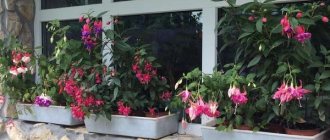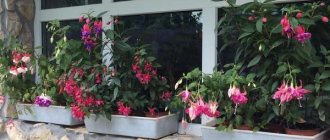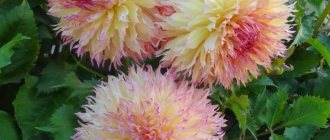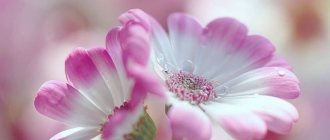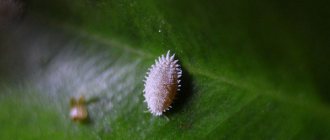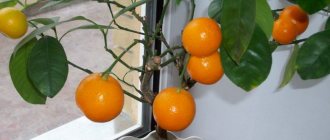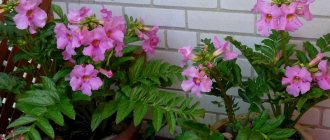Verbena is a very popular plant; there are incredibly many varieties of it.
In cold climates it is grown as an annual, and in regions with mild winters, verbena is cultivated as a perennial plant.
Ampelous verbena with beautiful flowing shoots is very popular among gardeners.
Botanical characteristics and history of appearance
The ampelous form is annual. This is a herbaceous plant that belongs to the family of the same name.
It is distinguished by its ability to bloom abundantly; more than 30 buds can bloom simultaneously on one stem . The flowers are small, with 5 petals, collected in umbrella inflorescences.
Interesting! Thanks to the work of breeders, flowers with heterogeneous color (with a white flower core) are found.
The homeland of verbena is America. It was from these two continents that verbena came to Europe, where it took root and spread further around the world.
Description of the plant
Verbena belongs to the Verbena family, which has more than 100 species, and is a herbaceous or semi-shrub plant. It can grow up to 1 m. The leaves are arranged in pairs opposite each other.
There are different flower color options
Flowers rarely exceed 2 cm in diameter. Collected in inflorescences of 30-40 pieces. Perennial verbena has a wide variety of colors: white, yellow, blue, pink, red, etc.
For your information! It is found naturally in America, Europe and Central Asia. Verbena serves as food for caterpillars. In garden conditions, some types of verbena are annuals.
The stems are tetrahedral, but sometimes this is not clearly expressed. They may be covered with a small fluff; this is a distinctive feature of the plant.
Not all gardeners have an idea of what verbena looks like. You can recognize the flower by its characteristic serrated leaves.
Description and photos of varieties
There are approximately 250 varieties . The most popular and widespread are the following.
Imagination
Long shoots are crowned with purple spherical inflorescences.
The bush quickly gains green mass and begins to bloom. Flowering is abundant and long lasting.
Attention! This verbena is used not only for landscaping terraces and balconies, but also as a ground-covering plant, since it quickly weaves the surface of a flower bed.
Lanai candy cane
A beautiful plant with shoots up to half a meter and bright red flowers.
The core of the flower has a crimson hue and stands out against the background of a white star-shaped spot.
Moon River
The variety has high decorative qualities. Its long vines are decorated with oblong leaves and lavender flowers.
Peach and cream
A distinctive feature of this variety was its unusual color, for which the plant was awarded the Flerselect medal in 1992.
The flowers combine pink, cream and apricot tones.
Mammut
An old variety, cultivated for a long time. The plant is remarkable for its elongated inflorescences and fairly long stems.
Tropic
The variety is distinguished by the beautiful even red color of its buds.
Temari (temari)
This variety is highly resistant to fungal infections.
The branched shoots are decorated with purple and purple flowers.
Tapien (tapien)
A bush with creeping shoots is literally dotted with small two-color buds.
It has a long flowering period and is easy to care for.
The Snow Queen
Plants of this variety have five different colors.
Empress peach
Compact shoots up to half a meter long are densely covered with a cap of creamy peach flowers.
Amethyst
A bush with long flowering and very beautiful white and purple flowers.
Quartz XP silver
The shoots of this variety are short (no more than 30 cm), strewn with white flowers with a silvery tint.
Hybrid verbena
Garden hybrid verbena (verbena hybrida) is a plant originating from the Verbenacea family, which is present in our climate as an annual, although perennial varieties are also found. Where does verbena grow? The plant comes from Europe, South and North America, and is grown quite often in our country.
Description, characteristics
These are garden flowers, characterized by a beautiful appearance, decorating balconies, terraces, and summer cottages.
Size . The plant usually grows to 20-45 cm in height, forming compact, irregular clumps. Some varieties reach a height of 1 m.
Verbena flowers bloom from July and bloom until late autumn. The inflorescences are large, dense, and take on different colors:
- white;
- violet;
- pink;
- red.
Flower petals may have colored spots or stripes. Small five-petal flowers have a uniform color or a core of a different color, the so-called eye. Flowers are collected in decorative, dense inflorescences.
Verbena flower, photo
The stems creep below, and the erect shoots have characteristic hairs.
The leaves are green, oval or oblong.
Varieties
Verbena hybrida, especially the red variety, is common in our country but does not occur naturally in the flora. The plant has no essential requirements; it needs a sunny position and fairly fertile soil.
The simple cultivation and care of verbena, along with its many decorative qualities, is a compelling argument in favor of choosing this plant to decorate the garden or an indoor variety intended for growing in pots on the balcony or terrace. Hybrid varieties include about 12 popular names, which can be divided into 2 main groups:
- with vertical stems;
- ampelous - with long hanging stems. What does ampel verbena look like? A popular variety is ampelous varieties, that is, grown in hanging pots, flowerpots, and cache-pots. The plant has drooping shoots.
Ampelous verbena, photo
Ampelous verbena with long pendulous stems
The varieties belonging to this group are characterized by high resistance to rain and wind. This balcony verbena has long, pendulous stems and is often planted in tall pots. The most common varieties include:
- "Temari Pink" - has large inflorescences with purple flowers;
- “Tapien Pink” – distinguished by pink flowers;
- "Tapien Blue" - the variety produces beautiful flowers with a dark purple color.
Varieties with straight vertical stems
Varieties of this group are used mainly for planting in beds and in small pots that are placed on the terrace or balcony. The plant will allow you to enjoy beautiful decor from spring to late autumn. This group includes varieties:
- "Malgosia" - distinguished by bright red flowers with a white eye;
- “Amulet” – blooms in white;
- 'Talisman' is a variety characterized by cherry blossoms with a white eye.
Division by size
Hybrid varieties can be divided into 3 groups according to the height that the plants reach:
- Grandiflora - the tallest varieties, reaching a height of 50 cm (Peaches and Creams).
- Compacta – varieties with an average height of about 30 cm (“Yanina”, “Magda”, “Vesia”, “Obsession”, “Novalis”, “Romeo”).
- Compacta Nana is the lowest variety, reaching 15 cm in height.
Interesting varieties
Bonar (Patagonian) verbena or "Buenos Aires"
The variety Verbena bonariensis deserves special mention. An example of a beautiful, slender plant, unusually elegant. The variety was imported from South America to European gardens in 1832. In nature it grows along the banks and inside humid forests. Buenos Aires verbena immediately gained great recognition due to its versatility and eventually received a medal from the Royal Horticultural Society. In our climate it is an annual plant.
Patagonian verbena has surprisingly hard, durable, slightly branched, hollow stems with longitudinal carved leaves. Reaches a significant height - up to one and a half meters. Panicle-shaped flowers in purple-pink form a subtle accent at the top of the stem, appear in July and bloom until frost, arranged side by side like little umbrellas, swaying gently in the wind.
Tuscany
An elegant, compact plant. Winner of Europe's highest award for its unique color and unsurpassed flowering power, which begins in late spring and continues until summer (regardless of the weather). The flowers are small and grow tightly in rounded clumps above large, jagged green foliage. The buds may resemble pelargonium. Each petal is a darker purple, making the vast array of flowers stand out even more.
Popular varieties with red and scarlet flowering
The most popular varieties have red flowers.
Tiara red impr (tiara red impr, or red imperial crown)
Bright red inflorescences look advantageous against the background of dark green foliage.
The bush is compact, unpretentious, and can withstand short frosts.
Estrella voodoo star
Flowers with two-tone colors - white and bright red.
Obsession Burgundy
Or an obsessive cascade. Refers to new varieties of verbena with high resistance to common diseases (for example, powdery mildew) and decorative qualities.
Why is it called “the flower of the thrifty”
Hosta (70 photos): planting and care, growing
It's simple: the seeds of such a crop can be stored for a long time (two years, and in some species even longer), germinate quickly, and the bushes bloom for a long time and brightly.
Verbena (some people call it dove grass) is a healing plant for some people, and a magical flower for others.
The homeland of this decorative culture is not Eurasia, but America, South and North.
You can recognize the plant by:
- elongated green leaves, shaggy, with teeth along the edges (my guests sometimes confuse the non-flowering verbena bush with mint);
- bushes of different heights - from 20 cm to a meter;
- small flowers collected in dense inflorescences, one-color or two-color (the color of verbena flowers can be different - purple, blue, light blue, white, red, yellow, cream);
- compact, shallow root system.
Verbena blooms from the first week of June to the last week of October. One bush can bloom up to 30 inflorescences at a time.
Cultivated species
In total, botanists have listed about 120 species. Among them are herbaceous plants and shrubs. But here you can see only a few variants of verbena.
Hybrid verbena. The most popular decorative species, bred from several varieties. The bush grows to a maximum of 50 cm. It is decorated with a large number of branches, as well as flowers of any shade - hybrid verbena has the most varieties. The most popular: “Cardinal” or “Julia” (large-flowered varieties), “Pink Delight”, “Crystal”, “Amethyst” (compact varieties).
Canadian. Low (up to 20 cm) annual. It blooms with lilac, pink or white small flowers.
Tough. A species with lilac flowers, creeping tetrahedral stems, and fleecy elongated leaves. The seeds of this species are the most durable - their germination capacity remains for a record 5 years.
Buenos Aires. The tallest type - the bushes grow up to 120 cm. The stems stretch straight, the side branches begin to grow near the ground. Inflorescences are formed from a large number of small pink flowers.
Ampelnaya. A fast-growing annual with shoots of about 60 cm. Flowers can be of various shades.
Lemon. A perennial with medicinal properties. It is grown not for beauty (since the flowers of such verbena are not so decorative), but for benefit.
Medicinal. It has an antispasmodic effect, and can also stabilize blood pressure and help with intestinal disorders.
Depending on the species, verbena can be either an annual or a perennial plant. However, most of our outdoor verbenas are annuals due to the fact that they cannot survive the frosts of the northern or central zone. And only in the southern regions can perennial verbena overwinter without dying.
Planting and growing from seeds at home
In annual growing conditions, it makes sense to plant bushes as seedlings, that is, sow seeds and grow seedlings in advance in order to transfer verbena to a flowerpot or flowerbed in the spring.
Growing seedlings
The optimal time for sowing seeds is early to mid-spring.
Important! You should not delay sowing seeds, otherwise the seedlings will not have time to gain leaf mass and flowering will be delayed or will not occur at all.
Therefore, if the planting date has been missed, it is more advisable to purchase ready-made seedlings.
For sowing, you can purchase universal soil for seedlings . It should be nutritious, loose, with high drainage capacity.
It is recommended to warm the seeds before planting. In this case, they can be placed in a damp cloth and left on the battery overnight.
There is no need to bury the seeds in the soil; just sprinkle them with a little substrate. Place the container in a warm, well-lit place and moisten it with a spray bottle.
Shoots should appear on days 5–7. If this does not happen, shock therapy is used. The pot with the crops is placed on the radiator for about 2–3 hours, and then in the refrigerator overnight. After this treatment, the seedlings hatch already on the 3rd day .
When to plant in the ground
It is recommended to plant seedlings in the ground no earlier than mid-May , when the threat of return frosts has passed. Before transplanting into open ground, seedlings need to be hardened off for 2 weeks, taking them out onto a balcony or terrace for several hours.
Growing in open ground
Verbena, which is not particularly difficult to plant and care for, is distinguished by its unpretentiousness and beautiful flowering. Garden and balcony varieties love bright, illuminated places, otherwise they will not bloom, but will only grow green mass.
The main condition for care is systematic watering. Do not allow it to dry out, so you need to water the plant three times a week. The drainage layer will ensure the removal of excess moisture.
You can add fallen leaves, sawdust or moss to the soil, this will retain moisture.
Verbena requires some care. It does not tolerate low temperatures, but can survive short droughts. He also perceives minor weather fluctuations normally.
Verbena produces flowers from the beginning of June, and they last until October. In autumn, watering is gradually reduced.
Planting and care photo
Verbena is light-loving, so they choose an open, sunny place for it.
Lighting, air, temperature
Do not move pots of verbena into the shade: it must receive enough ultraviolet light to bloom profusely. In addition, it is better to choose a place where there are no drafts, but the bush is forgiving to temperature conditions .
Important! Most varieties tolerate short-term drops in temperature well.
The soil
It is advisable to select light, loose soils, but in general, verbena is not capricious and undemanding to the quality of the soil.
Watering
Watering should be done moderately but regularly. Optimal watering regime: do not allow the top layer of soil to dry out , but do not allow moisture to stagnate.
Feeding
Fertilizers are applied throughout the growing season . They begin fertilizing with nitrogen complexes, and from the moment of transplanting into open ground, nitrogen is replaced with potassium-phosphorus fertilizers.
Caring for verbena
Verbena is undemanding in conditions of maintenance and is considered an unpretentious plant. To grow it you need:
- Sunny place. Tolerates light partial shade.
- Neutral or slightly alkaline soil with good aeration (with the addition of coarse sand or vermiculite)
- Moderate watering (so that water does not accumulate).
- At the beginning of the season, fertilizing with nitrogen fertilizers is relevant, during the budding period - phosphorus-potassium fertilizers (ready-made fertilizers for flowering plants are sold in stores).
- After planting, the space around the plant is mulched. For this purpose, rotted last year's sawdust or mowed grass is used. The grass is inspected for seeds so as not to introduce weeds into the flower garden.
Verbena ampelous
Important! Faded inflorescences are picked off for abundant and long flowering.
Reproduction
Verbena is propagated by cuttings and by growing from seeds.
Cuttings of ampelous verbena
A bush that was harvested for the winter is subjected to cuttings. In February–March it is removed from the basement and cuttings are prepared.
For this:
- the apical part of the shoots is cut off (at least 5 leaves);
- maintain a distance of at least 1 cm between the lower leaf and the place where the cutting is cut off;
- the lower 2 leaves are removed, the cut is treated with “Kornevin”;
- the cuttings are planted in a loose sand-peat mixture up to the lower pair of cut leaves;
- It is recommended to cover the cuttings with a jar to form a greenhouse;
- Watering is carried out as the top layer of soil dries;
- The jar is removed daily for 10–20 minutes for ventilation.
The cuttings take root in 4–5 weeks.
Collecting and planting seeds
Verbena seeds have good germination rates, so many gardeners collect them after flowering . Store the seeds in a paper bag at room temperature and plant them in March–April to grow seedlings.
Planting in garden flower beds and pots
To plant verbena in open ground, it is best to choose a well-lit place, since the plant is very heat-loving and grows well even in dry conditions.
The soil should be loose, light; first, it should be enriched with humus and fertilized with a special compound (for example, humus). Ideal PH 5.8-6.2.
Be sure to prevent the occurrence of frost. Despite the cold resistance of adult plants, seedlings can slow down in growth when exposed to sub-zero temperatures. Transplanting verbena into a permanent location is usually carried out in mid/late May.
Low-growing verbenas are planted at a distance of 20 cm from each other, ampelous and groundcover - at a distance of 25-30 cm. Tall varieties will require even more space; they are planted at intervals of 25-35 cm.
Verbena Lanai Blush White in open ground
If planting is done in indoor pots, be sure to make drainage. To do this, place a layer of pebbles or expanded clay on the bottom of the container, and only then fill the form with the soil mixture.
The same verbena - Lanai Blush White - but in hanging boxes
The transplant is made using the transshipment method. This means that the sprout is removed from the container along with a lump of earth. This way the root system of the plant will remain intact, and it will more quickly take root in a new place.
The finished pots are placed in the sunniest spot, where it is possible to create a constant flow of fresh atmosphere for the plant.
Pests and diseases
Verbena rarely gets sick, since this plant is resistant to most diseases. However, if watering is improper, root rot can develop . Timely replanting and revision of the watering regime can save the plant.
Among the pests, aphids parasitize verbena . If a parasite is detected, the plant is treated with insecticides.
Growing problems
Problems when growing verbena rarely arise because it is resistant to pests and diseases.
During cool and rainy periods or when there is excessive waterlogging, powdery mildew may develop on the stems and foliage. At the first signs of the disease, the affected areas are cut off and burned so that the pathogen does not spread further to healthy specimens. The remaining parts are generously treated with a solution of “Fundazol” or “Saprol”. Treatments are carried out three to four times at intervals of several days.
Damage to the crop by mites, aphids and nematodes is rarely observed. Most often this happens when planting is too dense and improperly maintained with excessive watering. To get rid of these diseases, solutions of insecticides are used, which not only treat the above-ground parts, but also water the soil. Mospilan, Aktaru, Actellik, Confidor Extra, etc. are used as insecticides.
Varieties of flowers
The high popularity of verbena in floriculture is due to the unpretentiousness, attractiveness of the flower and its wide variety of species. Below are the names and descriptions of various types of verbena flowers, as well as their photos:
- Canadian.
Belongs to perennials. Under favorable climatic conditions, flowering can last until the end of October. The bush is short - 20 cm. The shape of the leaves is openwork, the inflorescences are in delicate shades - white, pink, lilac. - Tough.
A variety of verbena that is grown in Russia as an annual, despite the fact that it is considered a perennial. The color of the inflorescence is lilac. Hard, pubescent, elongated leaves are concentrated on the branched stems. - Buenos Aires. This plant variety should be classified as tall, since the stems can grow up to 1 m.
A perennial subshrub or shrub forms many lateral branches with thin leaves of a jagged and elongated shape.The inflorescences are umbrella-type, the leaves are jagged and elongated. The perennial blooms are represented by small lilac flowers.
- Hybrid.
The variety was obtained from several species. The plant is herbaceous, its height reaches 50 cm, and has many side shoots. The leaves are drooping and shaped like a triangle. The variety is distinguished by a wide palette of flowers. There are 30 types in total - from the lightest to the darkest. Find out more about hybrid (finely cut) verbena here.
Important! The main advantage of verbena over other types of ornamental flowering crops is that it blooms for a long time and has high seed germination even if stored for 2 years.
Read more about verbena varieties Buenos Aires, Bonar and others here.
Also, lovers of verbena may be interested in reading about ampelous verbena and its medicinal properties and its benefits and contraindications.
Preserving verbena in the house in winter
Hybrid verbena can overwinter at home so that when warmer weather arrives, the gardener can plant it again in its original place in an outdoor flowerpot or flower garden. The plant does not tolerate frost or even light frost. Therefore, work with it is carried out in advance, without waiting for really cold nights.
Pot of blooming verbena on the windowsill
In autumn (September), all damaged, broken and withered shoots and inflorescences are cut off from the bush. The bush is dug up and moved to a pot of a suitable size. Then they are transferred to a bright room, where a stable temperature of 4-7 °C is maintained throughout the cold season. Periodically it is necessary to moisten the earthen ball, preventing it from completely drying out.
Important! Keeping the plant warm in winter is only possible with regular feeding and additional lighting, creating a daylight duration of 10-12 hours.


